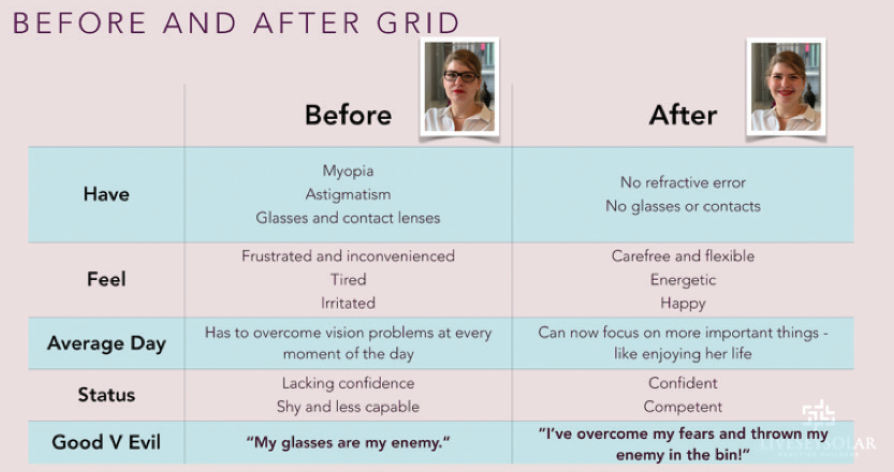

People don’t desire surgery. They desire a transformation from who they are now (their before state) to who they want to become (their after state). The more significant the transformation, the higher the value you can place on your service in exchange (Figure 1). This article describes how you can use the 40:40:20 rule of marketing to transform your dull, old messages to messages that appeal to your patients’ deepest hopes and desires.

Figure 1. Effective marketing articulates the patient’s move from the before state to the after state.
In a previous article, we discussed the patient avatar (http://bit.ly/solar0719). Creating an avatar is the first step toward defining whom you aim to attract to your practice. This article discusses a tool you can use to leverage the patient avatar. You will discover how important it is to illustrate the before and after of the avatar before you treat him or her.
INTRODUCING THE BEFORE-AND-AFTER GRID
We are indebted to the work of Ryan Deiss of DigitalMarketer for first sharing the before-and-after grid concept with us.1 The before-and-after grid is a simple but powerful tool you can use to help identify which messages will:
- Tell your patients that you recognize them;
- Show them that you empathize with their pains and challenges;
- Demonstrate that you can relate to their everyday experiences; and
- Enable you to align yourself with their values so that they trust you to guide them.
To get the most out of this article, follow along and do a before-and-after exercise using the grid template in Figure 2. Replace the prompts with what your patient avatar has and feels before and after his or her treatment. Describe his or her average day before and after the surgery and explore how others see him or her before and after the procedure. Finally, identify the narrative in which people see themselves as the heroes of their own stories.

Figure 2. Complete this exercise to map out a marketing strategy for your patient avatar.
Take a look at the marketing communications for your practice—your website, blog posts, social media activity, and videos. What are they talking about? Most vision correction providers talk about what patients have, such as nearsightedness, farsightedness, or astigmatism. Some talk about how patients feel, such as their frustration and annoyance with glasses. Professional marketers talk about “good versus evil” by positioning the patient as the hero in his or her battle over glasses and contact lenses. Further, they characterize the provider as the guide in the hero’s epic narrative.
THE FIRST 40 OF THE 40:40:20 RULE
We advise you to devote a significant proportion (40%) of your messaging to reflect how difficult it is for your patient avatar to live with the problems of his or her before state. Your copy and images should act as an empathetic friend. An expression of the before state in text might read:
Living with glasses and contact lenses is hard, especially in a world that favors people with perfect vision. Squinting, dryness, inconvenience, and hassle are all parts of your day when you’re a glasses or contact lens wearer. Worse, you may dislike the way your glasses look or feel, and you may be worried about the high risk of contact lens infection after prolonged use.
This copy is an expression of the patient avatar’s before state. The images in Figure 3 achieve a similar result by reflecting the patient’s most frustrating moments in his or her battle with glasses and contact lenses.

Figure 3. Your marketing should reflect the patient’s most frustrating moments with glasses and contact lenses.
You might be thinking, “Aren’t you supposed to show people living a wonderful life after glasses and contact lenses?” Not entirely. This messaging calls out the avatar and lets him or her know you recognize, empathize, and help people just like him or her transform into their desired after state. Prospective patients will only give you their trust to guide them once they’re convinced that you understand them.
THE SECOND 40 OF THE 40:40:20 RULE
We advise you to devote an equal proportion (40%) of your messaging to inspiring your patient avatar with images showing him or her in the desired after state. Your copy and images could be aspirational and read:
Imagine seeing the world without glasses or contact lenses. You can have the freedom that some patients call life-changing. Most patients say they wish they had done it sooner. You may feel more confident and will undoubtedly experience more convenience.
Why not just show the after state? Because social media, and advertising in general, are awash with images that look just like those depicted in Figure 4. Marketers can use them to sell just about anything. Because your patient avatars see these images consistently, they’ve become numb to them.

Figure 4. Beware of sharing generic images of happy people in your marketing. Your target audience sees this kind of image so often they may be numb to it.
THE FINAL 20 OF THE 40:40:20 RULE
You, the vision correction provider, are an essential criterion in your patients’ decision-making process. Patients answer these questions—in order—when choosing to have vision correction:
1. Why fix the problem? (the before state)
2. Why fix it with this solution? (the after state)
3. Why fix it with this provider? (your practice)
4. Why fix it now? (the timing)
You are not the hero of the story. Your patient is. To draw on Star Wars mythology, be the Obi-Wan Kenobi to your patient’s Luke Skywalker.
Devote a small proportion (20%) of your messaging to positioning yourself as the guide in the hero’s story. That includes references to:
- Surgeons;
- Doctors;
- Staff;
- Facilities; and
- Technology.
CONCLUSION
The 40:40:20 rule is the marketing communications equivalent to listening for 80% of the time and talking for 20% of the time. The lion’s share of any marketing and sales conversation (even one-directional conversations like most marketing communications) should be all about your patient avatar, equally divided into his or her before and after states. You use the remaining share of to show prospective patients that you are perfectly positioned to empathize with them and to lead them to where they want to go. Only then will you be in an optimal position to guide patients toward their desired after state and the transformation that they truly seek.


